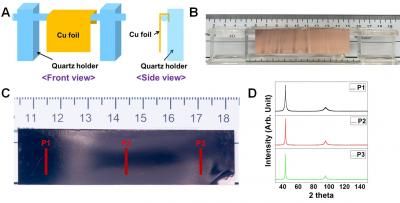New catalyst for hydrogen production
With the aid of platinum catalysts, it is possible to efficiently produce hydrogen. However, this metal is rare and expensive. Researchers have discovered an alternative that is just as good, but less costly.

It doesn’t always have to be precious metals: Ulf-Peter Apfel and his colleagues discovered a promising new catalyst material.
© RUB, Kramer
The mineral pentlandite is a potential new catalyst for hydrogen production. As described in the journal “Nature Communications”, it works just as efficient as the platinum electrodes commonly used today. In contrast to platinum, pentlandite is affordable and found frequently on Earth. A team headed by Dr. Ulf-Peter Apfel and Prof. Dr. Wolfgang Schuhmann of the Ruhr-Universität Bochum describes the results together with colleagues from the Max-Planck-Institute for Coal Research in Mülheim an der Ruhr and the Technical University of Bratislava.
Producing hydrogen without precious metals
In addition to platinum, there are numerous other substances that can catalyse the reaction of water to hydrogen and oxygen and do not contain any precious metals. Among such compounds are the so-called metal chalcogenides. Usually, however, these non-metallic materials are distinctly poorer conductors of electrons and are thus inefficient catalysts. Pentlandite consists of iron, nickel, and sulfur. Its structure is similar to the active center of hydrogenases, which are hydrogen-producing enzymes, as found, for example, in green algae. In the current study, the researchers compared the hydrogen production rate of naturally obtained and artificially produced pentlandite with platinum and other non-metallic catalysts.
Mineral pentlandite just as good as platinum
Artificial pentlandite and platinum prove to be equally good catalysts, with a performance that surpasses that of all the other materials tested. The mineral synthesized in the lab produced hydrogen much more efficiently than the naturally found variant. The reason: Inclusions of magnesium and silicon in natural pentlandite reduce its conductivity. The scientists called the output of artificial pentlandite “surprisingly high”, and the rate of synthesis also remained stable for a long time. The mineral has another advantage compared to other non-precious-metal materials. It has a greater active surface area to which the reacting substances can dock. In other non-precious-metal materials, this surface has to be created using complex methods by applying the catalyst to an electrode in the form of nanoparticles.
Original publication
Bharathi Konkena, Kai junge Puring, Ilya Sinev, Stefan Piontek, Oleksiy Khavryuchenko, Johannes P. Dürholt, Rochus Schmid, Harun Tüysüz, Martin Muhler, Wolfgang Schuhmann & Ulf-Peter Apfel; "Pentlandite rocks as sustainable and stable efficient electrocatalysts for hydrogen generation"; Nature Comm.; 2016
Original publication
Bharathi Konkena, Kai junge Puring, Ilya Sinev, Stefan Piontek, Oleksiy Khavryuchenko, Johannes P. Dürholt, Rochus Schmid, Harun Tüysüz, Martin Muhler, Wolfgang Schuhmann & Ulf-Peter Apfel; "Pentlandite rocks as sustainable and stable efficient electrocatalysts for hydrogen generation"; Nature Comm.; 2016
Topics
Organizations
Other news from the department science

Get the chemical industry in your inbox
By submitting this form you agree that LUMITOS AG will send you the newsletter(s) selected above by email. Your data will not be passed on to third parties. Your data will be stored and processed in accordance with our data protection regulations. LUMITOS may contact you by email for the purpose of advertising or market and opinion surveys. You can revoke your consent at any time without giving reasons to LUMITOS AG, Ernst-Augustin-Str. 2, 12489 Berlin, Germany or by e-mail at revoke@lumitos.com with effect for the future. In addition, each email contains a link to unsubscribe from the corresponding newsletter.



























































